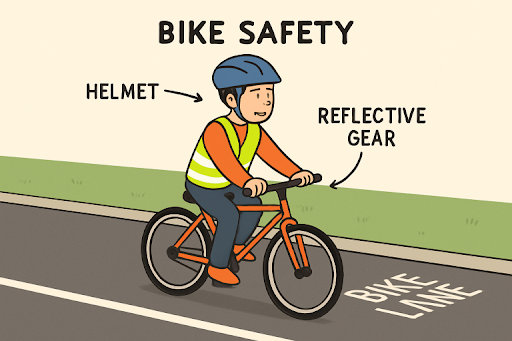Key Takeaways
- Recognizing common bicycle accident injuries ensures quicker, more effective treatment.
- Consistent use of protective gear and adherence to traffic rules significantly reduce the risk of injury.
- Structured recovery plans, including medical attention and rehabilitation, hasten the return to cycling.
Biking is a rewarding activity that offers improved physical health, stress relief, and environmental benefits. However, with the rise in cycling popularity, more riders are exposed to the risk of accidents. Understanding common injuries and efficient recovery steps enables cyclists to safeguard themselves and their journeys better. If you’re involved in a collision, consulting a bike accident attorney can help protect your rights and assist with the aftermath of an incident.
Being proactive about safety and recovery not only reduces the severity of injuries but also speeds up your return to the road. Awareness and safe riding habits make it possible to enjoy cycling’s many benefits while minimizing dangers. Regular cycling builds stamina, but a single accident may lead to a variety of injuries that demand both immediate care and structured rehabilitation plans.
Common Bike Accident Injuries
Bicycle accidents may cause a wide spectrum of injuries, from minor scrapes to severe trauma. Rapid identification and treatment are crucial for minimizing complications and promoting safe recovery.

1. Head Injuries
Head injuries often rank among the gravest outcomes for cyclists. Concussions, traumatic brain injuries (TBIs), and post-concussive syndromes must be taken seriously, even if initial symptoms seem mild. Statistics show that wearing a properly fitted helmet can dramatically reduce the risk of sustaining a serious head injury. In fact, helmeted cyclists face less than half the risk of head trauma compared to those who ride without one.
2. Upper Body Injuries
Roughly a quarter of all injured cyclists suffer from damage to their upper limbs. Falls or collisions can cause shoulder dislocations, wrist fractures, and hand or arm sprains. The shoulder is particularly prone to injuries, ranging from soft tissue tears to fractures of the collarbone. Proper positioning and bike handling, along with the use of padded gloves and attentive awareness, can help reduce upper limb impact.
3. Facial Injuries
Falls can expose the face to the pavement or obstacles, resulting in broken noses, jaw or cheekbone fractures, eye injuries, and dental trauma. The American Dental Association strongly advises the use of mouthguards to prevent dental injuries during rides. Eye protection and properly fitted helmets that cover the brow can also help reduce the severity of facial injuries. Some facial injuries may require urgent medical attention and specialist care, especially if vision or breathing is affected.
4. Road Rash
“Road rash” is perhaps the most familiar wound among cyclists—abrasions caused by skin scraping against rough surfaces after a fall. While most road rash injuries are shallow and superficial, they can be painful due to the exposure of nerve endings. Severe abrasions require vigilant cleaning to prevent infection and may necessitate medical care, while less intense scrapes can be managed with home first aid and sterile dressings.
Recovery Strategies
Thorough recovery requires a balance of immediate medical evaluation, structured rehabilitation, and a gradual reintroduction of activity. Being patient and attentive during rehabilitation reduces the risk of long-term complications.
1. Immediate Care
After an accident, always seek medical evaluation—even for seemingly minor symptoms. Early assessment and swift wound management help identify injuries like concussions or internal bruising that aren’t always obvious. Delaying medical visits can lead to preventable complications.
2. Physical Therapy
Guided physical therapy rebuilds lost strength, flexibility, and coordination. Whether you experience joint stiffness, muscle weakness, or nerve sensitivity, rehabilitation exercises tailored to your specific injuries can considerably boost your recovery speed. Adhering to a plan from a licensed therapist is strongly recommended for optimal outcomes.
3. Gradual Return to Cycling
Once your healthcare provider deems you ready, start with slow, low-intensity rides on familiar terrain. Incrementally increase distance and challenge levels, always listening to your body’s response. Rushing the recovery process or ignoring pain can trigger setbacks or further injury.
Preventive Measures
Adopting reliable safety habits not only protects you from the initial impact of accidents but also reduces their frequency and severity overall. Taking prevention seriously ensures a safer, more enjoyable cycling experience.
1. Wear a Helmet
Invest in a certified, properly fitted helmet that meets national safety standards. Evidence shows that cyclists wearing helmets are significantly less likely to sustain life-threatening head trauma during falls and collisions.
2. Use Reflective Gear
Wearing reflective or brightly colored clothing enhances your visibility to drivers and fellow cyclists, particularly during dusk, dawn, or in adverse weather conditions. Lights and reflectors on both the bike and the rider add further safety—especially in urban traffic or low-visibility conditions.
3. Follow Traffic Rules
Understanding and obeying road signals, riding with traffic, and using clear hand signals for turns all contribute to safer riding environments. Staying alert and anticipating driver actions can prevent many avoidable incidents.
Final Thoughts
Knowledge is power when it comes to bike safety and recovery. Recognizing typical bicycle accident injuries and knowing how to respond can shorten healing time and prevent complications. Combining diligent preventive measures with smart rehabilitation strategies empowers cyclists to enjoy the freedom and health benefits of biking safely.



